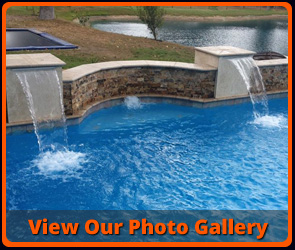There are few home improvements as impressive, and challenging, as adding an inground pool to your property. Pools are great for gatherings, exercise, and relaxation. The benefits can outweigh the cost of inground pool installation for many people.
There are many factors that need to be addressed before your pool is built. Before all of that, you need to work out how much you’re going to be spending.
Cost of Inground Pool Installation
That cost is different for every homeowner as there are many options for inground swimming pools. You’ll need to account for size, accessories, and any patio work you want to be done around it.
Size
This is the biggest factor that determines your cost to build. Bigger pools are obviously going to be more expensive to build and maintain than smaller pools.
If you aren’t sure how big it should be, then take a look around your yard. How much of your property are you willing to convert into a pool area? This tells you how big it can be.
Now think of what you want to use it for. Do you just want a pool to float around and relax in, or something longer for laps? Even consider whether you want to install certain features like a waterfall or bar in the pool.
An average-sized pool ends up being around 12-feet by 24-feet and $20,000 to install. Remember that a pool isn’t just a cement pit full of water. There are pipes, valves, and drains necessary to the maintenance and cleanliness of the pool.
Material
Different materials have different prices. Crazy, right? The primary materials used in inground pools are vinyl, fiberglass, and concrete, each with their own benefits.
Fiberglass is the cheapest option, running between $20,000 and $36,000, but that doesn’t mean it’s the worst. A fiberglass pool is installed as a single shell and needs some deck built around it. Fiberglass is very easy to keep clean and the shell doesn’t need much special care.
Vinyl gets a bit more expensive, from $20,000 to $40,000. Vinyl is easy to maintain and keep clean. Vinyl is also difficult for algae to take hold on, so it won’t need much chemical treatment, which can make it cheaper in the long run.
Concrete pools can be a bit pricier, going from $30,000 to $50,000 and requiring more in long-term maintenance. Thanks to the stability of concrete, they tend to be the larger pools. Though due to their size, the initial cost of filling them and the subsequent costs of maintenance come out to be the highest of the pools.
There are online calculators that can get you a rough estimate of the installation cost like this one. But the best way to know for sure is to get a consultation from a professional service.
Accessories
A pool’s a pool, but a pool with some extra features is something special. If you’ve got the space and the budget, consider adding some accessories to your pool.
A waterfall addition looks great and doesn’t add too much to the overall cost of the pool. Kits go from several hundred to a few thousand dollars.
If you have kids, then they will probably want a slide. Try and count this as an early birthday present because a permanent one will cost thousands of dollars. If you don’t want to spend that much, smaller inflatable ones can be under $100.
To really get the most out of your pool, it’s best to think of it as a continuation of your patio. With this mindset, you can consider any patio piece as part of the pool.
A poolside bar is great during parties and barbeques. A simple rolling bar for storage and prep can easily cost under $100, but a permanent fixture with refrigeration can go into the thousands. Make sure to keep an eye out for broken glass.
If you plan it out beforehand, a hot tub can be integrated into your pool for two kinds of luxury. It’s definitely a high-cost upgrade, probably $7,000 to $16,000 extra, but it is certainly worth it. Swim in the cool pool during the heat of the day and climb into the hot tub when the sun goes down to relax.
Maintenance
Like a pet, a pool’s expenses don’t end after you get it. Pools need to be maintained or they’ll suffer. Nobody wants to swim in a swamp so keep your pool clean.
Cement pools will require acid washing every few years to look as clean as possible, and eventually, it will need to be re-shelled. This can cost about $27,000 after a decade of regular maintenance and utility prices. The nature of cement makes it easier for algae growth.
Vinyl and fiberglass pools don’t have as much algae growth since they are much smoother and have fewer places for algae to latch on. These cost about $13,000 to maintain on average.
It can get pricey. Assume to pay up to $5,000 a year in maintenance for an average pool. This includes the chemicals, tools, electricity, and repairs to keep the pool clean and running.
You can save money by caring for your pool on your own. Once you have the tools, you only need to buy the chemicals which vary by brand.
If your pool is not inside of a screened-in patio, consider buying a cover. The price depends on size and material just like the pool itself. If your pool is a shape other than a rectangle it may cost more as well to get it custom-made.
A pool cover helps reduce the amount of debris like dirt, leaves, bugs, and other waste from getting in when the pool isn’t being used. The less time you have to spend cleaning, the more time you spend enjoying the pool.
Add It Up
Take advantage of the Texas sun and plan to swim all year. Once you have your total cost of inground pool installation, give us a call or message us for a free consultation.
Our custom-made pools can meet your needs and our financing can help you afford it.




